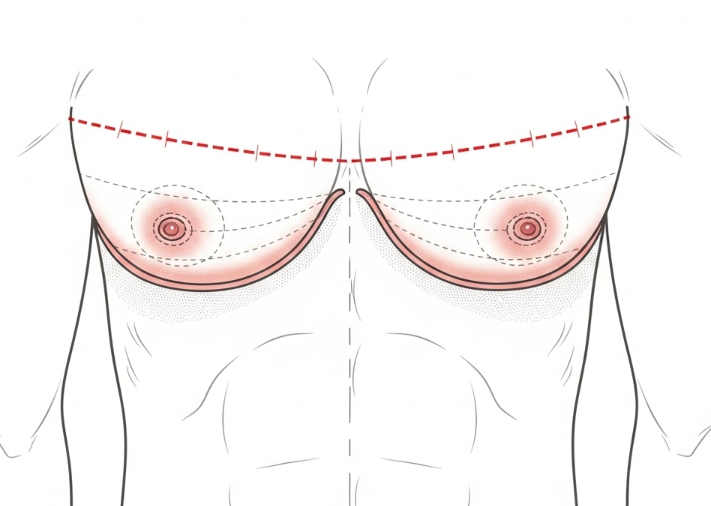Treatment Overview
The Double-Incision Mastectomy is the most common and reliable form of FTM (female-to-male) top surgery for patients with medium-to-large chest size or lower skin elasticity. This procedure removes breast tissue and excess skin through two horizontal incisions across the chest, while also repositioning and resizing the nipples for a natural, masculine appearance.
In Korea, highly trained plastic surgeons combine aesthetic precision with advanced surgical techniques to achieve smooth, flat chest contours and minimize scarring. Korea is increasingly recognized as a destination for gender-affirming surgery, offering high-quality results at more affordable prices compared to Western countries.
Purpose & Benefits
- Chest Masculinization: Creates a flat, masculine chest shape.
- Skin Removal: Ideal for patients with larger chests or skin laxity.
- Nipple Resizing & Repositioning: Nipples are adjusted for masculine placement (often with free nipple grafts).
- Permanent Results: Removes breast tissue permanently.
- Improved Confidence: Supports gender affirmation, body alignment, and mental well-being.
Ideal Candidates
- Trans men, non-binary individuals, and gender-diverse patients seeking chest masculinization.
- Patients with medium-to-large chest size or sagging skin.
- Individuals who may not be suitable for keyhole or peri-areolar top surgery due to chest size or skin elasticity.
- Adults in good physical health.
- Non-smokers or those willing to quit before and after surgery.
- Patients with realistic expectations about scars and healing.
Possible Risks & Complications
- Temporary pain, swelling, or bruising.
- Visible scarring across the chest fold (fades but remains permanent).
- Nipple graft risks (partial or total graft loss, changes in sensation).
- Asymmetry or contour irregularities.
- Rare risks: infection, hematoma, delayed wound healing.
Techniques Used
- Double Horizontal Incisions: Made across the chest fold to remove breast tissue and excess skin.
- Free Nipple Grafts (FNG): Nipples are removed, resized, and repositioned.
- Scar-Minimizing Suturing: Layered closures and adhesives used to reduce scar thickness.
- Optional Liposuction: Enhances contour around chest and underarms.
Recovery & Aftercare
- 1–2 weeks: Swelling, bruising, and tightness are most noticeable.
- 2–3 weeks: Return to light work and daily activities.
- 4–6 weeks: Resume light exercise (avoid chest workouts initially).
- 3–6 months: Chest contour settles, scars begin to fade.
Aftercare Guidelines:
- Wear a compression vest for 4–6 weeks to reduce swelling.
- Care for nipple grafts as instructed by the surgeon.
- Avoid heavy lifting and strenuous activity early in recovery.
- Use silicone scar sheets or creams to minimize scarring.
- Attend scheduled follow-ups for wound and contour assessment.
Results & Longevity
- Flat, masculine chest contour (visible right after surgery, final results once swelling resolves).
- Permanent breast tissue removal, ensuring long-lasting results.
- Natural nipple placement with resized areolas.
- Visible scarring (typically fades over time but will not disappear completely).
- Life-changing improvements in body confidence and gender congruence.
Treatment Process in Korea
1. Initial Consultation & Planning
- Surgeons assess chest size, skin elasticity, and patient goals.
- Surgical plan designed, including nipple graft resizing and placement.
- Pre-surgery medical tests conducted.
2. Surgery Day
- Performed under general anesthesia.
- Two incisions across the chest fold; breast tissue and excess skin removed.
- Nipples resized and grafted into more masculine position.
- Drains may be placed to prevent fluid buildup.
3. Post-Operative Monitoring
- Compression garment applied immediately after surgery.
- Most patients stay 1 night in hospital; some discharged same day.
4. Follow-Up & Refinement
- Follow-up visits at 1 week, 1 month, and 3–6 months.
- Scar treatments or minor revisions may be recommended for refinement.
Why Korea is a Top Destination
- Surgeons with extensive experience in gender-affirming surgeries.
- Use of advanced scar management protocols (silicone sheets, laser therapy).
- Combination with 3D imaging and simulation for personalized planning.
- More affordable pricing compared to North America or Europe.
- Clinics in Seoul offer multilingual staff, discreet services, and international aftercare support.
Cost Range
The cost of Double-Incision Mastectomy in Korea (FTM Top Surgery) depends on clinic reputation, surgeon experience, and patient’s chest size.
Estimated Pricing:
- Standard Double-Incision Mastectomy: USD $8,000 – $11,000
- With Free Nipple Graft (FNG): USD $9,000 – $13,500
- With Liposuction & Contour Refinement: USD $10,000 – $14,000
- Premium Clinics (scar care + VIP aftercare): USD $12,000 – $16,000
Additional Costs:
- Consultation & pre-op tests: USD $200 – $500
- Compression vests: USD $150 – $300
- Scar management programs: USD $300 – $800
- Medications & aftercare: USD $200 – $400
Popular Clinics
- Banobagi Plastic Surgery (Seoul): Specialists in gender-affirming top surgery and scar refinement.
- ID Hospital (Seoul): Offers FTM surgery with advanced nipple grafting techniques.
- JK Plastic Surgery Center (Seoul): JCI-accredited, premium surgical and aftercare programs.
- View Plastic Surgery Clinic (Seoul): Experts in chest contouring and scar management.
- JW Plastic Surgery (Seoul): Known for natural-looking top surgery with customized nipple placement.




